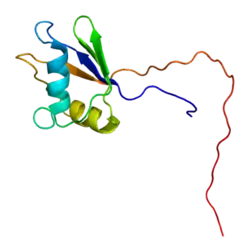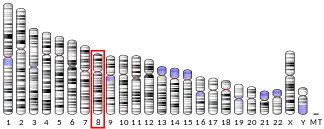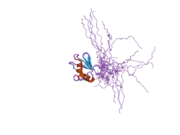PARP10
Poly [ADP-ribose] polymerase 10 is an enzyme that in humans is encoded by the PARP10 gene.[5][6]
Poly(ADP-ribose) polymerases (PARPs), such as PARP10, regulate gene transcription by altering chromatin organization by adding ADP-ribose to histones. PARPs can also function as transcriptional cofactors (Yu et al., 2005).[supplied by OMIM][6]
References
- GRCh38: Ensembl release 89: ENSG00000178685 - Ensembl, May 2017
- GRCm38: Ensembl release 89: ENSMUSG00000063268 - Ensembl, May 2017
- "Human PubMed Reference:". National Center for Biotechnology Information, U.S. National Library of Medicine.
- "Mouse PubMed Reference:". National Center for Biotechnology Information, U.S. National Library of Medicine.
- Ame JC, Spenlehauer C, de Murcia G (Jul 2004). "The PARP superfamily". BioEssays. 26 (8): 882–93. doi:10.1002/bies.20085. PMID 15273990. S2CID 25024719.
- "Entrez Gene: PARP10 poly (ADP-ribose) polymerase family, member 10".
Further reading
- Chou HY, Chou HT, Lee SC (2006). "CDK-dependent activation of poly(ADP-ribose) polymerase member 10 (PARP10)". J. Biol. Chem. 281 (22): 15201–7. doi:10.1074/jbc.M506745200. PMID 16455663.
- Kimura K, Wakamatsu A, Suzuki Y, et al. (2006). "Diversification of transcriptional modulation: large-scale identification and characterization of putative alternative promoters of human genes". Genome Res. 16 (1): 55–65. doi:10.1101/gr.4039406. PMC 1356129. PMID 16344560.
- Yu M, Schreek S, Cerni C, et al. (2005). "PARP-10, a novel Myc-interacting protein with poly(ADP-ribose) polymerase activity, inhibits transformation". Oncogene. 24 (12): 1982–93. doi:10.1038/sj.onc.1208410. PMID 15674325.
- Gerhard DS, Wagner L, Feingold EA, et al. (2004). "The status, quality, and expansion of the NIH full-length cDNA project: the Mammalian Gene Collection (MGC)". Genome Res. 14 (10B): 2121–7. doi:10.1101/gr.2596504. PMC 528928. PMID 15489334.
- Ota T, Suzuki Y, Nishikawa T, et al. (2004). "Complete sequencing and characterization of 21,243 full-length human cDNAs". Nat. Genet. 36 (1): 40–5. doi:10.1038/ng1285. PMID 14702039.
- Strausberg RL, Feingold EA, Grouse LH, et al. (2003). "Generation and initial analysis of more than 15,000 full-length human and mouse cDNA sequences". Proc. Natl. Acad. Sci. U.S.A. 99 (26): 16899–903. Bibcode:2002PNAS...9916899M. doi:10.1073/pnas.242603899. PMC 139241. PMID 12477932.
- Suzuki Y, Yoshitomo-Nakagawa K, Maruyama K, et al. (1997). "Construction and characterization of a full length-enriched and a 5'-end-enriched cDNA library". Gene. 200 (1–2): 149–56. doi:10.1016/S0378-1119(97)00411-3. PMID 9373149.
- Maruyama K, Sugano S (1994). "Oligo-capping: a simple method to replace the cap structure of eukaryotic mRNAs with oligoribonucleotides". Gene. 138 (1–2): 171–4. doi:10.1016/0378-1119(94)90802-8. PMID 8125298.
This article is issued from Wikipedia. The text is licensed under Creative Commons - Attribution - Sharealike. Additional terms may apply for the media files.





